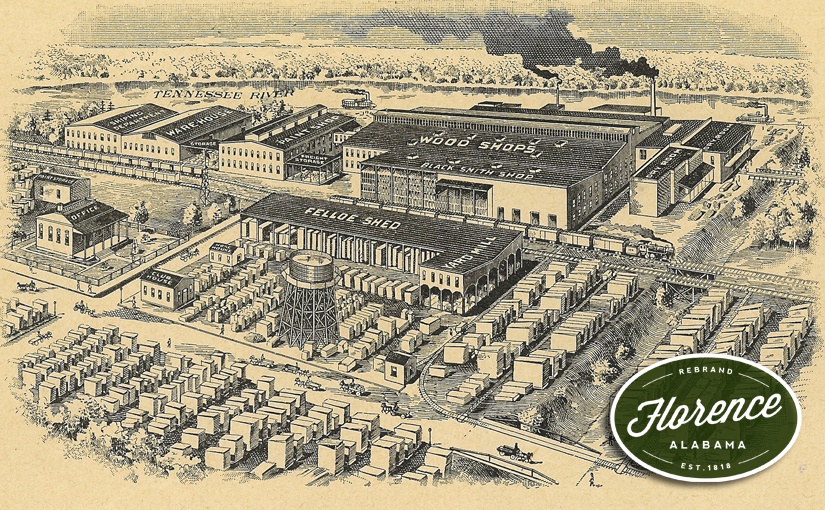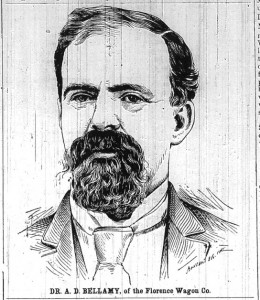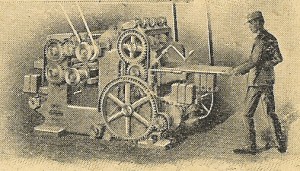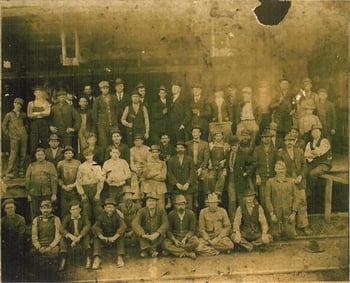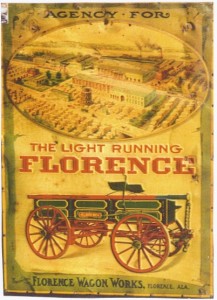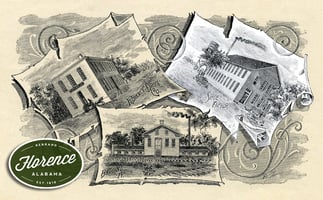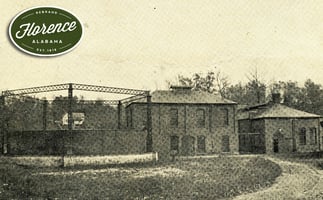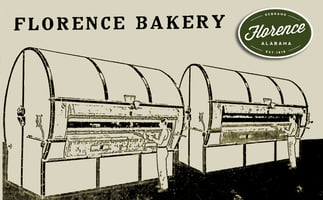REBRAND FLORENCE PARTNERSHIP Shoals History is excited to partner with the Rebrand Florence...
Florence Wagon Works
A Brief History of the Florence Wagon Works Factory.
By Lee Freeman from the Florence-Lauderdale Public Library.
In the 1800s, before cars had been invented, one way people got around was in wagons. Florence had several wagon and buggy manufacturing companies throughout the 19th century (most pre-1870). But the biggest and most famous of them was the Florence Wagon Works.
The Florence Wagon Works Factory came to East Florence, Alabama, from Atlanta, Georgia at the height of Florence’s industrial boom in 1889. At the time it was one of about sixty plants and businesses located in the booming city.
Founded by Dr. Alfred David Bellamy (1847-1913), a native New Yorker from Georgia, its first president, the Florence Wagon Works plant quickly grew to be the second largest wagon manufactory in North America, second only to the Studebaker Company.
Bellamy graduated from medical school in Chicago, but had to quit his practice in Atlanta after his hearing went bad. He then founded a wagon factory in Atlanta. The Doctor relocated it to Florence in 1889 because of the nearby timber forests, the Tennessee River and the railroad. It was cheaper to ship from Florence than Atlanta.
Besides building a wide range of “Light Running Florence” wagons, including its famous Farmer’s Handy Wagon, Florence Wagon Works also manufactured and sold buggies through its subsidiary the Florence Vehicle Company, and, in its later years as demands for wagons decreased, began producing lawn furniture; the company also did job machine work, as well as planing, matching and dressing lumber, and according to the Florence Herald by June of 1889 employed 200 wheelwrights, blacksmiths, painters and mechanics. By February of 1890 the factory work force had decreased to only 75 hands. Only nine moths later, in October of 1890, the company roster had increased to 125 hands. By January of 1897 a force of 160 hands was at work; by February of 1907 the Florence Times reported a force of 250 hands. However by September of 1933, at height of the Great Depression, the number of hands had decreased to just 30.
The Herald reported in January of 1890 that the Factory’s second shipment of 75 wagons had just left for Atlanta, to be followed every few days by further shipments. In February of 1892 the factory received 150 orders for wagons, fifty of which were destined for Florida. In September of 1894 the factory shipped 528 wagons. By 1897, its annual productivity was 6,000 wagons-this would later increase to 15,000. By about 1900 it was turning out 20-25 wagons a day.
Florence Wagon Works: Second largest in North America
Supposedly the second-largest wagon manufactory in North America (second only to Studebaker) and located on the Tennessee River, the plant had its own steamboat landing and railroad spur, dry house and lumber yard. The Wagon Factory also issued its own scrip (company money). Also the company had its own brass band, a company baseball team called the Wood Sawyers, an employee newspaper called The Florence Wagging Tongue, a Young Men’s Christian Association (YMCA), a library for the employees founded and stocked by Dr. Bellamy, as well as a commissary (restaurant), a Sunday school, “the Club House Sunday School,” founded by Mrs. Hamaker, wife of Supt. Hamaker, separate housing for black and white employees, a water tower (moved from Handy’s Hill in West Florence, in 1893), and its own fire department. In 1893 an Employees Improvement Association (E. I. A.) was founded which held dances, contests and other fundraisers, including raising money to take care of sick employees.
The Florence Wagon Works plant had the most up-to-date equipment available, including a large Hamilton Corliss engine and an indoor sprinkler system added in 1901. In October of 1894 electric lights were installed; by February of 1896 five telephones had been installed in the various different departments and in May of 1900 a “rapid roller copying machine” for copying letters on a long roll of paper was added, along with an “addressograph for addressing company letters.
Florence Wagon Works Expands
In 1905 the Florence Wagon Works company founded a subsidiary company, the Florence Vehicle Company, whose offices and show room were on the ground floor of the old Florence Hotel building, built ca. 1884, which building still exists and is now 111 South Court Street. The Vehicle Company served as a retail outlet for the company’s wagons and buggies.
By 1906, 2 1-8 red hickory wagon with seat and no brake cost $26. A delivery wagon on a 1 1-4 solid steel axle with any firm name lettered on the side at no extra cost was $65. A 2 3-4 wagon complete with spring seat and gear brake was $57.50 and a 2 1-8 Florence with spring seat, no brake cost $30.50. A 3 1-4 log wagon with 3 inch tires cost $90.
During WWI the company built wagons for the US Army Expedition to France. Prior to this, it had shipped orders of wagons to several oversees locations and foreign countries, including Hawaii, Puerto Rico, India, South Africa, Russia, and Mexico.
After the invention of cars as demand for wagons decreased in the 1920s and 30s, the Florence Wagon Works factory wasn’t able to diversify and eventually relocated to North Carolina in the 1940s. The Florence Wagon Club exists to honor the memory of this Florence industry. Each May the club holds a Wagon Works Festival at McFarland Park at which restored Florence Wagons are displayed and tribute is paid to the men and women of the Florence Wagon Company who, during its over fifty years of loyal service, made “Light Running Florence” a household word.
The Florence Wagon Works plant was bought in April of 1941 by the firm of Trenholm & Starr, Inc., of Chattanooga, Tennessee, which operated cotton warehouses. The new owners planned to use the plant for some type of national defense purposes during WWII, which they never actually did. The last remnants of the company were purchased and relocated to Hickory, North Carolina, along with some of the employees.
REBRAND FLORENCE PARTNERSHIP
Shoals History is excited to partner with the Rebrand Florence Instagram project. Each company from Florence’s past that is rebranded through the Rebrand Florence project will have an associated post here on the Shoals History website. Some research and images are graciously provided through a partnership with the Florence-Lauderdale Public Library‘s Local History department.
